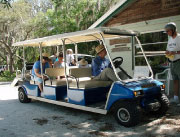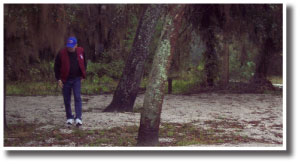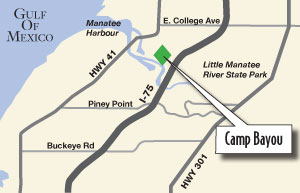 |
||||||||
Camp Bayou:
 A Special Place for Kids of All Ages
A Special Place for Kids of All Ages
In a region known for its sprawling nature preserves and meticulous habitat restorations that cover thousands of acres, Camp Bayou stands out for what it isn’t:
- First, it’s not really a camp. There are no facilities for overnight stays and no summer camp programs – although campers from other programs are welcome on field trips.
- Secondly, it’s a learning center as much as a nature preserve, where professional staff and experienced volunteers lead ongoing programs that encourage kids and adults to learn more about the region’s history and rich natural resources.
- It’s also a living laboratory that demonstrates how successfully a waterfront RV park can be transformed into a natural area that provides habitat for a wide range of species including gopher tortoises, alligators and perhaps even the endangered Florida panther.
- Finally, it’s one of the first properties purchased with funds from Hillsborough County’s Environmental Lands Acquisition and Protection Program but ongoing events are funded through a series of partnerships with private organizations ranging from the Ruskin Community Development Foundation and paleontologist Frank Garcia to Audubon Society and Boy Scouts.
The partnerships mean that something fun and exciting happens nearly every weekend – plus provide staffing to accommodate the hundreds of school children who visit the camp every year.

A 7-passenger golf cart makes it easy for both youngsters and seniors to see the diverse habitats at Camp Bayou. Tours are scheduled every Saturday morning. Reservations are recommended, call 813-641-8545.
“What we really want to do is make it easy for people to learn about the natural history and ecosystems of central Florida,” notes Dolly Cummings, director of Camp Bayou Learning Center. For instance, hikers can easily traverse the three trail areas, but the camp also offers golf cart tours on most Saturday mornings. “It makes it easier for older people as well as families with young children to see the site,” she says.
Its relatively small size – just 160 acres compared to thousands of acres in nearby preserves along the Little Manatee River – also makes it easy to learn about diverse habitats. Three separate trails and a canoe loop highlight wetlands, uplands habitats and riverine ecosystems, plus it’s part of the Great Florida Birding Trail where large, easily identifiable birds like pileated woodpeckers and red-shouldered hawks make it a great place for beginners.
The butterfly habitat, created with assistance from the Eagle Audubon Society, is intentionally “not called a butterfly garden because it has the weeds that butterflies need for their caterpillars,” Cummings said. Trained butterfly monitors track populations year-round while Cummings leads an informal group on the third Friday of every month. “You have to be a trained monitor to submit data to the Florida Butterfly Monitoring Network but we’re always glad to have interested people follow along in a less-formal way.”

Located in an oxbow of the Little Manatee River, Camp Bayou schedules occasional guided canoe tours. Canoes can be launched year-round at the dead-end of 24th Street.
The newest addition at Camp Bayou is the Leisey-Casey Discovery Center and the Paleo Preserve where many of the paleontological treasures found at the nearby Leisey Shell Pit are displayed. “Leisey is the most important ice-age site in the world, and this is probably the finest paleo-research library south of Gainesville,” said Garcia, who led the team that excavated thousands of fossils from the pit.
Outside, a replica pit has been salted with fossils to ensure that children have the opportunity to “discover” fossils from long-ago Florida. “Kids really love this place,” says Garcia, who enjoys the experience so much that he’s often on-site when the preserve opens on Saturday mornings. “It’s something to watch them find a shark’s tooth – it’s an experience they’ll never forget.”
Other highlights of Camp Bayou include a replica Native American campsite designed and built by a team of three Eagle Scouts that highlights how the first residents of this land lived. A demonstration garden is designed to show homeowners how they can incorporate native plants into modern suburban landscapes, and a native nursery where plants grown by volunteers are for sale.

Photos courtesy Camp Bayou
Campers re-create an Native American village to learn how the region's first residents lived off the land.

Ongoing Citizen-Scientist programs at Camp Bayou allow visitors to participate in a wide variety of monitoring programs.

Paleontologist Frank Garcia, shown above, has created a replica of the famed Leisey Shell Pit at Camp Bayou. It’s open every Saturday from 9 a.m. to 2 p.m.
The nature center features an excellent resource center with reference materials in a wide range of formats, from books, magazines and displays to an extensive collection of insects found at Camp Bayou cataloged by a retired entomologist who volunteers at the center.
Programs Galore
While visitors are free to roam Camp Bayou without guides, many children and families come specifically for the programs which range from river studies that let kids wade into the Little Manatee River with nets to see what lives beneath the surface to hands-on classes that demonstrate native American skills like weaving and pottery. A series of “Citizen Scientists” programs allow students to participate in monitoring programs including plant surveys, bird counts, butterfly transects or burrow life censuses.
“We have programs that work for kids from kindergarten through high school,” Cummings said. “They come from schools, church groups and organizations like Boy Scouts.” All the Camp Bayou programs have been correlated to the Sunshine State Standards. Upon request, Camp Bayou can provide a series of FCAT-style questions related to the specific program the class has scheduled.
Cummings, a native of New York who started with Camp Bayou as a volunteer, has a BS in biology and is a member of the North American Association of Environmental Educators and the League of Environmental Educators of Florida (LEEF). “This is my dream job,” she says. “Growing up there was a little park near us and I knew then that this is what I wanted to do.”
Along with formal programs for children, events are scheduled regularly for adults and families. Friday mornings feature the Camp Bayou Walk-About, with experienced volunteers leading a moderately paced hike on the trails of Camp Bayou. Evening walks scheduled for just after sunset offer a different perspective on nature, on land and water as well as a guided view of the nighttime sky.

Camp Bayou is open Thursday through Saturday from 9 a.m. to 2 p.m. Dogs on hand-held leashes are permitted and poop-scooping is required. To get there, take Interstate 75 to Exit 240 (Ruskin). Head west on SR 674 about ½ mile to 24th Street SE, turn left and travel south about three miles. The road ends in the park, turn left at the second set of gates, or you’ll end up in the river.
A favorite for kids of all ages is the Family Naturalist program held the first Saturday of every month. Topics range from watersheds and Florida-friendly landscaping to biodiversity and keystone species, with an online network at www.familynaturalists.ning.com that includes photos, videos, a nature journal and a calendar of events, plus downloadable field guide pages.
Camp Bayou also participates in national geocaching programs as well as letterboxing events through www.atlasquest.com. Like geocaching but without the GPS, letterboxing allows participants to seek out hidden treasures in parks and cities around the world. Once the box is discovered, letterboxers stamp their personal journal with the rubber stamp and then place their signature stamp into the letterbox’s log.
